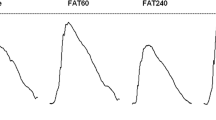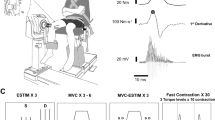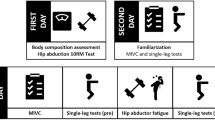Abstract
Purpose
The purpose of this investigation was to evaluate alterations in muscular effort and temporal characteristics of their activity during the sit-to-stand (STS) due to isolated fatiguing of the knee extensors, as indicated by declines in torque output.
Methods
Surface electromyography of the lower extremity was recorded in healthy young (n = 11) and older (n = 11) adults as they ascended from a seated position, before and after dynamic knee extension exercise.
Results
Knee extensor fatigue caused significant increases in soleus, gastrocnemius, and gluteus maximus relative effort (%MVC) in both age groups during the STS task. Rectus femoris %MVCs in both young and older adults significantly increased to similar extents throughout the STS movement, whereas vastus lateralis amplitudes only increased in preparation for seat-off. Muscle temporal characteristics appeared to generally be invariant with fatigue, except for earlier activation onset for the ankle musculature in older adult participants.
Conclusions
These findings demonstrate that isolated knee extension fatiguing exercise caused compensatory changes in muscle activation patterns and increased reliance of non-fatigued muscles at the ankle and hip as well as increased activity of synergist muscles during the STS. Moreover, this occurred to similar extents in older adults who had lower knee extensor strengths and greater quadriceps %MVCs in comparison to their younger counterparts, regardless of fatigue condition.






Similar content being viewed by others
Abbreviations
- BF:
-
Biceps femoris
- EMG:
-
Electromyography
- GAS:
-
Gastrocnemius
- GMax:
-
Gluteus maximus
- MVC:
-
Maximal voluntary contraction
- RF:
-
Rectus femoris
- SOL:
-
Soleus
- STS:
-
Sit-to-stand
- VL:
-
Vastus lateralis
References
Akima H, Foley JM, Prior BM, Dudley GA, Meyer RA (2002) Vastus lateralis fatigue alters recruitment of musculus quadriceps femoris in humans. J Appl Physiol 92(2):679–684
Akima H, Takahashi H, Kuno SY, Katsuta S (2004) Coactivation pattern in human quadriceps during isokinetic knee-extension by muscle functional MRI. Eur J Appl Physiol 91(1):7–14
Avin KG, Law LA (2011) Age-related differences in muscle fatigue vary by contraction type: a meta-analysis. Phys Ther 91(8):1153–1165
Bassey EJ, Fiatrone MA, O’Neill EF, Kelly M, Evans WJ, Lipsitz LA (1992) Leg extensor power and functional performance in very old men and women. Clin Sci 82:321–327
Bieryla KA, Anderson DE, Madigan ML (2009) Estimations of relative effort during sit-to-stand increase when accounting for variations in maximum voluntary torque with joint angle and angular velocity. J Electromyogr Kinesiol 19(1):139–144
Bilodeau M, Henderson TK, Nolta BE, Pursley PJ, Sandfort GL (2001) Effect of aging on fatigue characteristics of elbow flexor muscles during sustained submaximal contraction. J Appl Physiol 91(6):2654–2664
Bohannon RW (2009) Body weight-normalized knee extension strength explains sit-to-stand independence: a validation study. J Strength Cond Res 23(1):309–311
Bonnard M, Sirin AV, Oddsson L, Thorstensson A (1994) Different strategies to compensate for the effects of fatigue revealed by neuromuscular adaptation processes in humans. Neurosci Lett 166(1):101–105
Brech GC, Alonso AC, Luna NMS, Greve JM (2013) Correlation of postural balance and knee muscle strength in the sit-to-stand test among women with and without postmenopausal osteoporosis. Osteoporos Int 24(7):2007–2013
Bryanton MA, Bilodeau M (2016) Postural stability with exhaustive repetitive sit-to-stand exercise in young adults. Hum Mov Sci 49:47–53
Bryanton MA, Carey JP, Kennedy MD, Chiu LZ (2015) Quadriceps effort during squat exercise depends on hip extensor muscle strategy. Sports Biomech 14(1):122–138
Burnfield JM, Shu Y, Buster TW, Taylor AP, McBride MM, Krause ME (2012) Kinematic and electromyographic analyses of normal and device-assisted sit-to-stand transfers. Gait Posture 36(3):516–522
Carville SF, Perry MC, Rutherford OM, Smith ICH, Newham DJ (2007) Steadiness of quadriceps contractions in young and older adults with and without history of falling. Eur J Appl Physiol 100:527–533
Chiu LZ, Bryanton MA, Moolyk AN (2012) Proximal-to-distal sequencing in vertical jumping with and without arm swing. J Strength Cond Res 28(5):1195–1202
Corrigan D, Bohannon RW (2001) Relationship between knee extension force and stand-up performance in community-dwelling elderly women. Arch Phys Med Rehabil 82(12):1666–1672
Dehail P, Bestaven E, Muller F, Mallet A, Robert B, Bourdel-Marchasson I, Petit J (2007) Kinematic and electromyographic analysis of rising from a chair during a “Sit-to-Walk” task in elderly subjects: role of strength. Clin Biomech 22(10):1096–1103
DeVita P, Hortobagyi T (2000) Age causes a redistribution of joint torques and powers during gait. J Appl Physiol 88(5):1804–1811
Ebenbichler G, Kollmitzer J, Quittan M, Uhl F, Kirtley C, Fialka V (1998) EMG fatigue patterns accompanying isometric fatiguing knee-extensions are different in mono-and bi-articular muscles. Electroencephalogr Clin Neurophysiol Electromyogr Motor Control 109(3):256–262
Eriksrud O, Bohannon RW (2003) Relationship of knee extension force to independence in sit-to-stand performance in patients receiving acute rehabilitation. Phys Ther 83(6):544–551
Flanagan SP, Salem GJ (2008) Lower extremity joint kinetic responses to external resistance variations. J Appl Biomech 24(1):58
Fujita E, Kanehisa H, Yoshitake YA, Fukunaga T, Nishizono H (2011) Association between knee extensor strength and EMG activities during squat movement. Med Sci Sports Exerc 43(12):2328–2334
Godin G, Shepard RJ (1997) Godin and Leisure-Time Exercise Questionnaire. Med Sci Sports Exerc 29:S36–S38
Goulart FRDP, Valls-Solé J (1999) Patterned electromyographic activity in the sit-to-stand movement. Clin Neurophysiol 110(9):1634–1640
Gregoire L, Veeger HE, Huijing PA, van Ingen SG (1984) Role of mono-and biarticular muscles in explosive movements. Int J Sports Med 5(6):301–305
Gross MM, Stevenson PJ, Charette SL, Pyka G, Marcus R (1998) Effect of muscle strength and movement speed on the biomechanics of rising from a chair in healthy elderly and young women. Gait Posture 8(3):175–185
Hermens HJ, Freriks B, Merletti R, Stegeman D, Blok J, Rau G, Disselhorst-Klug C, Hägg G (1999) European recommendations for surface electromyography. Roessingh Res Dev 8(2):13–54
Horak FB, Shupert CL, Mirka A (1989) Components of postural dyscontrol in the elderly: a review. Neurobiol Aging 10(6):727–738
Hortobágyi T, Mizelle C, Beam S, DeVita P (2003) Old adults perform activities of daily living near their maximal capabilities. J Gerontol Ser A Biol Sci Med Sci 58(5):M453–M460
Hug F (2011) Can muscle coordination be precisely studied by surface electromyography? J Electromyogr Kinesiol 21(1):1–12
Hughes MA, Myers BS, Schenkman ML (1996) The role of strength in rising from a chair in the functionally impaired elderly. J Biomech 29(12):1509–1513
Hunter SK, Critchlow A, Enoka RM (2004) Influence of aging on sex differences in muscle fatigability. J Appl Physiol 97(5):1723–1732
Kallio J, Sogaard K, Avela J, Komi P, Selanne H, Linnamo V (2012) Age-related decreases in motor unit discharge rate and force control during isometric plantar flexion. J Electromyogr Kinesiol 22(6):983–989
Kanekar N, Aruin AS (2012) Aging and balance control in response to external perturbations: role of anticipatory and compensatory postural mechanisms. Age 36(3):1067–1077
Kellis E (1999) The effects of fatigue on the resultant joint moment, agonist and antagonist electromyographic activity at different angles during dynamic knee extension efforts. J Electromyogr Kinesiol 9(3):191–199
Kent-Braun JA, Ng AV (1999) Specific strength and voluntary muscle activation in young and elderly women and men. J Appl Physiol 87(1):22–29
Kouzaki M, Shinohara M, Fukunaga T (1999) Non-uniform mechanical activity of quadriceps muscle during fatigue by repeated maximal voluntary contraction in humans. Eur J Appl Physiol 80(1):9–15
Ikezoe T, Mori N, Nakamura M, Ichihashi N (2011) Atrophy of the lower limbs in elderly women: Is it related to walking ability? Eur J Appl Physiol 111:989–995
Larsen AH, Puggaard L, Hämäläinen U, Aagaard P (2008) Comparison of ground reaction forces and antagonist muscle coactivation during stair walking with ageing. J Electromyogr Kinesiol 18(4):568–580
LeRoche DP, Cromin KA, Greenleaf B, Croce RV (2010) Rapid torque development in older female fallers and non-fallers: a comparison across lower-extremity muscles. J Electromyogr Kinesiol 20:482–488
Muhlberg W, Sieber C (2004) Sarcopenia and frailty in geriatric patients: Implications or training and prevention. Z Gerontol Geriatr 37:2–8
Nagai K, Yamada M, Mori S, Tanaka B, Yemura K, Aoyama T, Ichihashi N, Tsuboyama T (2013) Effect of the muscle coactivation during quiet standing on dynamic postural control in older adults. Arch Gerontol Geriatr 56(1):129–133
Paillard T (2012) Effects of general and local fatigue on postural control: a review. Neurosci Biobehav Rev 36(1):162–176
Petrella JK, Kim JS, Tuggle SC, Hall SR, Bamman MM (2005) Age differences in knee extension power, contractile velocity, and fatigability. J Appl Physiol 98(1):211–220
Puniello MS, McGibbon CA, Krebs DE (2001) Lifting strategy and stability in strength-impaired elders. Spine 26(7):731–737
Renshaw D, Bice MR, Cassidy C, Eldridge JA (2010) A comparison of three computer-based methods used to determine EMG signal amplitude. Int J Exerc Sci 3(1):43–48
Roos MR, Rice CL, Vandervoort AA (1997) Age-related changes in motor unit function. Muscle Nerve 20:679–690
Savelberg HHCM, Fastenau A, Willems PJB, Meijer K (2007) The load/capacity ratio affects the sit-to-stand movement strategy. Clin Biomech 22(7):805–812
Shaffer SW, Harrison AL (2007) Aging of the somatosensory system: a translational perspective. Phys Ther 87(2):193–207
Tucker MG, Kavanagh JJ, Barrett RS, Morrison S (2008) Age-related differences in postural reaction time and coordination during voluntary sway movements. Hum Mov Sci 27(5):728–737
Van Zandwijk JP, Bobbert MF, Munneke M, Pas P (2000) Control of maximal and submaximal vertical jumps. Med Sci Sports Exerc 32(2):477–485
Van Roie E, Verschueren SM, Boonen S, Bogaerts A, Kennis E, Coudyzer W, Delecluse C (2011) Force-velocity characteristics of the knee extensors: an indication of the risk for physical frailty in elderly women. Arch Phys Med Rehabil 92(11):1827–1832
Van der Heijden MM, Meijer K, Willems PJ, Savelberg HH (2009) Muscles limiting the sit-to-stand movement: an experimental simulation of muscle weakness. Gait Posture 30(1):110–114
Vigotsky AD, Harper EN, Ryan DR, Contreras B (2015) Effects of load on good morning kinematics and EMG activity. PeerJ. 3:e708
Walshe AD, Wilson GJ, Ettema GJ (1998) Stretch-shorten cycle compared with isometric preload: contributions to enhanced muscular performance. J Appl Physiol 84(1):97–106
Wretenberg P, Arborelius UP (1994) Power and work produced in different leg muscle groups when rising from a chair. Eur J Appl Physiol 68(5):413–417
Yoshioka S, Nagano A, Himeno R, Fukashiro S (2007) Computation of the kinematics and the minimum peak joint moments of sit-to-stand movements. Biomed Eng Online 6(1):26
Author information
Authors and Affiliations
Contributions
MAB conceptualized the study, carried out the data collection and statistical analyses, and wrote and edited the manuscript. MB participated in the conception and design of the study, provided advice and content expertise, and revised the manuscript. All authors read and approved the final manuscript.
Corresponding author
Additional information
Communicated by Lori Ann Vallis.
Rights and permissions
About this article
Cite this article
Bryanton, M.A., Bilodeau, M. The influence of knee extensor fatigue on lower extremity muscle activity during chair rise in young and older adults. Eur J Appl Physiol 119, 61–71 (2019). https://doi.org/10.1007/s00421-018-3999-4
Received:
Accepted:
Published:
Issue Date:
DOI: https://doi.org/10.1007/s00421-018-3999-4




